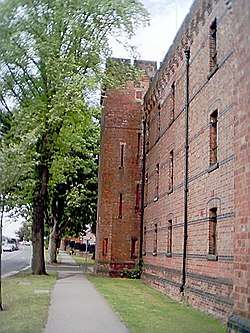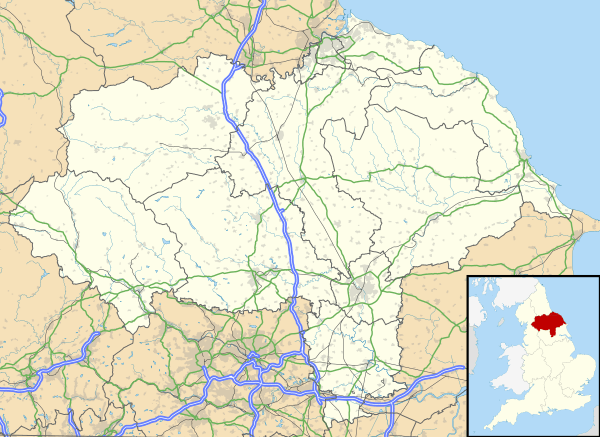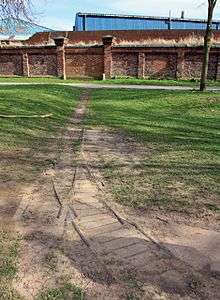Imphal Barracks
Imphal Barracks is a military installation located in Fulford, York, England.
| Imphal Barracks | |
|---|---|
| York | |
 The walls of Imphal Barracks | |
 Imphal Barracks Location within North Yorkshire | |
| Coordinates | 53°56′37″N 01°04′26″W |
| Type | Barracks |
| Site information | |
| Owner | Ministry of Defence |
| Operator | |
| Site history | |
| Built | 1877–1878 |
| Built for | War Office |
| In use | 1878–Present |
| Garrison information | |
| Occupants | 1st (United Kingdom) Division |
History
Cavalry barracks were built in Fulford as part of the British response to the threat of the French Revolution and were completed in 1795 but these have now been largely demolished.[1] The infantry barracks, which were built between 1877 and 1878, were initially the depot of the 14th Regiment of Foot who arrived from Bradford Moor Barracks in 1878.[1] Their creation took place as part of the Cardwell Reforms which encouraged the localisation of British military forces.[2] Following the Childers Reforms, the 14th Regiment of Foot evolved to become the West Yorkshire Regiment with its depot at the barracks in 1881.[3] Under the Cardwell Reforms the two battalions of the 25th (Sussex) Regiment of Foot also established a depot at the barracks but following the Childers Reforms that regiment evolved to become the King's Own Scottish Borderers and moved to Berwick Barracks in 1881.[3]
In the 1950s the barracks were renamed Imphal Barracks to reflect the battle honours won by the West Yorkshire Regiment at the Battle of Imphal in spring 1944 during the Second World War.[4] The barracks became the home of the Prince of Wales's Own Regiment of Yorkshire when the West Yorkshire Regiment amalgamated with the East Yorkshire Regiment in 1958.[1]
The barracks also became the home of Northern Command in 1958.[1] North East District was established at the barracks in 1967 and Northern Command was disbanded in 1972;[5] the barracks additionally became the home of 2nd Division in 1982.[6] North East District merged with Eastern District to form an enlarged Eastern District at Imphal Barracks in 1992.[7] The enlarged district was disbanded on the formation of HQ Land Command in 1995.[8] 2nd Division, having absorbed Scotland District, moved its headquarters to Craigiehall, near Edinburgh in April 2000.[9]
In June 2006 a ceremony celebrating the formation of the Yorkshire Regiment was held at Imphal Barracks.[10] The new divisional headquarters of 6th Division marked its formation with a parade and flag presentation at Imphal Barracks on 5 August 2008.[11] It had a clear focus on preparing brigades for Afghanistan: during summer 2009, the divisional headquarters was significantly reinforced and transformed into Combined Joint Task Force 6 before deploying to Afghanistan as Regional Command South in November 2009.[12] The 6th division headquarters closed in April 2011.[13]
Imphal Barracks was the home of 15th Infantry Brigade[14] until 1 December 2014 when it merged with the former 4th Mechanised Brigade to form an infantry brigade known as 4th Infantry Brigade and Headquarters North East based in Catterick.[15] The barracks became home to 1st (United Kingdom) Division on 1 June 2015.[16]
In November 2016 the Ministry of Defence announced that the site would close in 2031.[17]
Narrow gauge railway

A horse-drawn narrow gauge railway with a gauge of 18 inch (457 mm) ran from the Ordnance Wharf at the River Ouse parallelly to Hospital Fields Road to the army depot. Military supplies and explosives were delivered by the schooner ‘Princess’ known locally as the ‘Powder boat’.[18]
References
| Wikimedia Commons has media related to Imphal Barracks, Fulford. |
- "A History of Imphal Barracks" (PDF). Ministry of Defence. Retrieved 29 March 2014.
- "Echoes of the past in these Army cuts". 8 July 2012. Retrieved 13 November 2014.
- "Training Depots". Regiments.org. Archived from the original on 10 February 2006. Retrieved 16 October 2016.CS1 maint: BOT: original-url status unknown (link)
- "The barracks', A History of the County of York: the City of York". 1961. pp. 541–542. Retrieved 29 March 2014.
- Paxton, J. (1972). The Statesman's Year-Book 1972-73: The Encyclopaedia for the Businessman-of-The-World. Palgrave Macmillan UK. p. 104. ISBN 978-0-230-27101-2.
- "BAOR locations". Retrieved 29 March 2014.
- "TA Command Structure 1967–2000". Archived from the original on 8 June 2011. Retrieved 2 February 2013.
- "Land Command Shapes Up", Jane's Defence Weekly, 15 July 1995.
- "Shots fired at Scottish Army headquarters near Edinburgh". Daily Record. 22 June 2011. Retrieved 29 March 2014.
- "Soldiers herald birth of Yorkshire Regiment". Yorkshire Press. June 2006. Retrieved 29 March 2014.
- "mod.uk". Archived from the original on 31 March 2012. Retrieved 29 March 2014.
- "6th Division". Ministry of Defence. Archived from the original on 13 August 2010. Retrieved 29 March 2014.
- "Military headquarters dissolved at Imphal Barracks". York Press. 4 April 2011. Retrieved 29 March 2014.
- "Fulford". Archived from the original on 29 March 2014. Retrieved 29 March 2014.
- "4th Infantry Brigade and HQ North East". Ministry of Defence. Retrieved 12 August 2015.
- "Homecoming of a Yorkshire general". The Press. 4 June 2015. Retrieved 10 August 2015.
- "A Better Defence Estate" (PDF). Ministry of Defence. November 2016. Retrieved 8 November 2016.
- Andrew Grantham: Narrow gauge military railway in York. Posted on 24 February 2011. Downloaded on 1 April 2017.